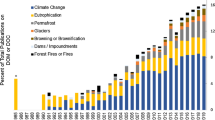Abstract
Here, we quantified sediment phosphorus (P) release in relation to concentrations of dissolved oxygen (DO) and sulphate, and increase in temperature in a major river of India subjected to long-term human perturbations. We found a substantial increase in sediment P release, an ecosystem feedback, at higher concentrations of sulphate, more towards the lower end of DO concentrations. A 2°C warming increased sediment P release upto 25.21% and caused a drop in DO level by 16%. Our findings reconcile the observed sulphate-driven changes in sediment P release across systems, and provide first experimental evidence of warming-induced increases. Our results imply that aquatic ecosystems will undergo self-fertilizing effect as the planet warming interacts with other human perturbations. This has implications for eutrophication linkages and ecosystem functioning.






Similar content being viewed by others
References
APHA (1998) Standard methods for the examination of Water and Wastewater. American Public Health Association, Washington, DC
Barneche DR, Hulatt CJ, Dossena M, Padfield D, Woodward G, Trimmer M, Yvon-Durocher G (2021) Warming impairs trophic transfer efficiency in a long-term field experiment. Nature 592(7852):76–79
Caraco NF, Cole JJ, Likens GE (1989) Evidence for sulphate-controlled phosphorus release from sediments of aquatic systems. Nature 341(6240):316–318
Chen M, Ding S, Chen X, Sun Q, Fan X, Lin J, Ren M, Yang L, Zhang C (2018) Mechanisms driving phosphorus release during algal blooms based on hourly changes in iron and phosphorus concentrations in sediments. Water Res 133:153–164
Dadi T, Schultze M, Kong X, Seewald M, Rinke K, Friese K (2023) Sudden eutrophication of an aluminum sulphate treated lake due to abrupt increase of internal phosphorus loading after three decades of mesotrophy. Water Res 235:119824
Diaz RJ, Rosenberg R (2008) Spreading dead zones and consequences for marine ecosystems. Science 321(5891):926–929
Hu WF, Lo W, Chua H, Sin SN, Yu PHF (2001) Nutrient release and sediment oxygen demand in a eutrophic land-locked embayment in Hong Kong. Environ Int 26(5–6):369–375
Jaiswal D, Pandey J (2019) Hypoxia and associated feedbacks at sediment-water interface as an early warning signal of resilience shift in an anthropogenically impacted river. Environ Res 178:108712
Lamers LP, Tomassen HB, Roelofs JG (1998) Sulfate-induced eutrophication and phytotoxicity in freshwater wetlands. Environ Sci Technol 32(2):199–205
Matta G, Kumar A, Nayak A, Kumar P (2022) Appraisal of spatial–temporal variation and pollution source estimation of Ganga River system through pollution indices and environmetrics in Upper Ganga basin. Appl Water Sci 12(3):33
Murphy JAMES, Riley JP (1962) A modified single solution method for the determination of phosphate in natural waters. Anal Chim Acta 27:31–36
Naqvi SWA, Bange HW, Farías L, Monteiro PMS, Scranton MI, Zhang J (2010) Marine hypoxia/anoxia as a source of CH 4 and N 2 O. Biogeosciences 7(7):2159–2190
Pandey J, Jaiswal D, Pandey U (2019) Point source-driven seasonal hypoxia signals habitat fragmentation and ecosystem change in River Ganga. Curr Sci 117(12):1947–1949
Park G, Oh H, Alm S (2009) Improvement of the ammonia analysis by the phenate method in water and wastewater. Bulletein of the Korean Chemical Society 30:2032–2038
Persson J, Wojewodzic MW, Hessen DO, Andersen T (2011) Increased risk of phosphorus limitation at higher temperatures for Daphnia magna. Oecologia 165:123–129
Sánchez E, Colmenarejo MF, Vicente J, Rubio A, García MG, Travieso L, Borja R (2007) Use of the water quality index and dissolved oxygen deficit as simple indicators of watersheds pollution. Ecol Ind 7(2):315–328
Siddiqui E, Pandey J, Pandey U et al (2020) Integrating atmospheric deposition-driven nutrients (N and P), microbial and biogeochemical processes in the watershed with carbon and nutrient export to the Ganga River. Biogeochemistry 147:149–178
Tabatabai MA, Bremner JM (1969) Use of p-nitrophenyl phosphate for assay of soil phosphatase activity. Soil Biol Biochem 1(4):301–307
Tabatabai MA, Bremner JM (1974) A rapid method for determination of sulphate in water samples. Environ Lett 7(3):237–243
Tammeorg O, Möls T, Niemistö J, Holmroos H, Horppila J (2017) The actual role of oxygen deficit in the linkage of the water quality and benthic phosphorus release: potential implications for lake restoration. Sci Total Environ 599:732–738
Tan KH (2005) Soil Sampling, Preparation, and analysis. CRC press, Taylor & Francis, Florida, p 623
Acknowledgements
The authors thank Head, Department of Botany, Banaras Hindu University for facilities. The University Grant Commission, New Delhi, and Institute of Eminence (IoE), BHU is acknowledged for funding support.
Author information
Authors and Affiliations
Corresponding author
Ethics declarations
Conflict of Interest
We state that there is no conflict of interest and all the authors are agree for its publication.
Additional information
Publisher’s Note
Springer Nature remains neutral with regard to jurisdictional claims in published maps and institutional affiliations.
Rights and permissions
Springer Nature or its licensor (e.g. a society or other partner) holds exclusive rights to this article under a publishing agreement with the author(s) or other rightsholder(s); author self-archiving of the accepted manuscript version of this article is solely governed by the terms of such publishing agreement and applicable law.
About this article
Cite this article
Gupta, B., Pandey, S. & Pandey, J. High Concentration of Sulphate Coupled with Climate Warming Generates Ecosystem Feedback Under Sub-Oxic Conditions at Sediment-Water Interface in the Ganga River. Bull Environ Contam Toxicol 111, 40 (2023). https://doi.org/10.1007/s00128-023-03790-w
Received:
Accepted:
Published:
DOI: https://doi.org/10.1007/s00128-023-03790-w




